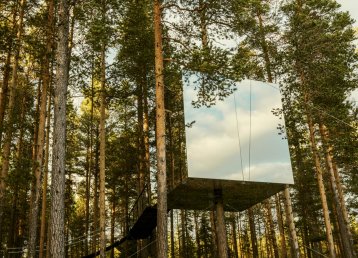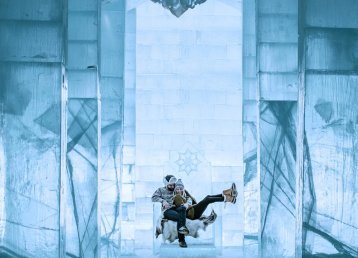The first impression
On a sunny day in mid-June, we enter the brand-new room Biosphere at Treehotel. World-famous architect Bjarke Ingels leads the way. It’s his first meeting with the new room too. He turns around in the doorway and looks happy.
— Welcome to Biosphere.
We stand there for a while and just let it all sink in. Recovering after the first impression. Then the architect in Bjarke takes over. A curious discoverer of his own work, looking for surprises. Into the sauna, up into the sleeping loft, further up onto the sun deck and then back downstairs before heading out again to view it from different angles, back inside to sit in the hanging chair and contemplate the creation further.
— I’m impressed we’ve managed to make it look like a sphere even though the room is a cube. All the bird houses on the outside give you the feeling that the room is spherical.
Bjarke leans back in the chair with a cup of coffee. A small bird flies up behind him to perch by one of the birdhouses. It’s as if it were here to inspect its new neighbourhood, see who’s moved into the large house today.
— Look at that little bird!
A success story
Bjarke Ingels has been called a genius, and probably for good reason. He was born in 1974 in Copenhagen and started studying architecture at university hoping it would help him become a better cartoonist – his real dream. But the architectural studies grew on him, and he continued his studies at Técnica Superior de Arquitectura in Barcelona. After various jobs, such as OMA in Rotterdam and PLOT, he founded BIG in 2005. It would turn into a success story. Today, BIG has offices in Copenhagen, New York, and Barcelona.
Biosphere is actually the first project to become a reality for the Barcelona office, from concept and sketch to a real hotel room among the treetops in Harads.
— Ever since the first wild ideas about a hotel with treehouses, Treehotel has always been driven by architecture. We began working with some of Sweden’s most famous architects and interior designers: Tham&Videgård, SandellSandberg, Cyrén&Cyren and Bertil Harström were the first ones, says the founder of Treehotel, Kent Lindvall, when we talk to him about the new room.
— When we built the sixth room, The Dragon Fly, it was a given that architects and architecture were important, so we chose the Finn Sami Rintala and the Icelander Dagur Eggertsson for that assignment.
— With the seventh room, called just that, ‘7th Room’, the large firms of the world entered the picture as that room was created by the famous Norwegian agency Snøhetta.
In a way it was a given that the eight room would be designed by a Danish architect. All the other rooms had been covered by the other Nordic countries, but a Danish architect was missing from Treehotel’s portfolio.
— Then there was nothing more natural than asking Bjarke Ingels. He’s one of the greatest architects of our time, says Kent.
”— Ever since the first wild ideas about a hotel with treehouses, Treehotel has always been driven by architecture.”
– Bjarke Ingels
The manifesto
Four years after Bjarke Ingels established BIG, he wrote his manifesto called “Yes is more”. When we ask him if it’s based on his personality, he answers that it’s more of an attitude. It’s important to say yes to the wider context. Saying yes to your own personal gain is easy, but to say yes to the development of society, that’s what’s ‘more’. In the manifesto Bjarke describes how architecture has almost got stuck in two parallel ruts. On the one hand, there’s avant-garde with madness and resistance architecture which easily – or at best – becomes nothing more than a curiosity. On the other hand, there’s traditional functionalism that won’t build anything other than what’s expected, in other words a rather boring box.
— In architecture these directions have dominated, but to us at BIG it’s more interesting to see what happens when they meet and interact. We want to work in that no man’s land, where they can overlap.
What is fascinating, as you read the manifesto, is that Bjarke Ingels already in 2009 writes that this overlap leads to an architecture that aims at creating socially, economically, and environmentally perfect spaces – or at least has it as an objective goal.
A ball of birdhouses
A couple of nights later I’m sleeping in Biosphere myself. The dominating impression from the outside – just as Bjarke himself experienced it – is the spherical shape. A sphere floating among the pine tops in the Harads forest. The spherical impression is visible at a distance. I feel it as I approach the room on the ramp. I walk into a ball of birdhouses. Even if the room itself is a cube, the 350 birdhouses mounted around the cube have created a sphere.
Architecture is also about framing the life you want to live. Most people would like a life without borders – a life that crosses borders, extends, and fulfils. In Biosphere the dark interior makes it possible for the large windows to let nature enter the room. The meeting between the outside and the inside is emphasised when almost 50% of the walls are glass and the rest absorbing, dark nuances. Your gaze is drawn to what’s outside. A chaffinch is sitting by the bird feeder when I get there. It feels amazing.
”— Bird feeding has become a necessary contribution in a changing world.”
– Bjarke Ingels
Yes is more
The first time Bjarke Ingels’ ‘hedonistic sustainability concept’ was noticed among the general public was probably when the drawings for Copenhill in Copenhagen were exhibited. It was an incineration plant that was going to be built with an artificial ski slope on the roof, with a drop height of 85 metres. Because a building is more than just a building – a building should give something back to its environment, even improve the environment. Yes is more. At Treehotel it was natural to think about what’s in the forest, and what will be affected in this forest if a hotel room is built.
— Interference in nature has an impact on the bird life, of course. So we thought about what could help the lives of small birds, and this idea with bird houses and bird feeding came up organically.
There’s also a strong tradition of bird watching in Harads, as the author and ornithologist Arne Blomgren used to live here. Among birdwatchers, Blomgren is known for his work on the Siberian jay. But when it comes to Biosphere and its design with the many bird houses and the large glass windows, Ulf Öhman from the Ornithological Society of Norrbotten has been lending a helping hand. It’s no secret that bird populations around the world are declining, and it’s even true for a place like Harads. But in Harads Bjarke Ingels wanted to create a building that wouldn’t adversely affect the bird population.
— When I visited Treehotel, before the pandemic and before this project had started, I felt as if I were in the middle of nature even though I was inside a comfortable hotel room. I was wondering if you could take it a step further and not just invite humans as hotel guests, but also others who love the forest.
— Also, since Treehotel has created an entire hotel room that works as a bird feeder and as bird houses, perhaps guests will take the initiative home with them. Because bird feeding has become a necessary contribution in a changing world.
The smell of wood
Bjarke Ingels returns to his coffee cup and to the room when the curious chaffinch has flown away. He laughs a little at the meeting. Says that he didn’t imagine birds would welcome the structure so quickly. Bjarke breathes in air through his nose and asks if I can “smell the wood”. The plywood is freshly painted, but yes, it’s there, the smell of wood.
— It’s wonderful to see the renaissance wood has experienced, even when it comes to large buildings. Here in the north it’s part of your everyday life, but now high-rise buildings as well as functional buildings are being built in the cities too. We [BIG] just won the competition for the new extension to Zürich airport. We’re building it in wood.
— Yes, a giant wooden house that will be ready in ten years’ time.
He stands up again, checks the features of the hidden minibar and then opens the door to the sauna and shower. Checks it again.
— Tonight I’m having a sauna, watching the bird life, he says and smiles.
Then he climbs back up to the sleeping loft and pulls down the automatic ladder that leads to the roof terrace. Because that’s how Biosphere is distributed. The lower floor consists of a sauna, shower and toilet, and a lounge. Above there’s the sleeping loft with a spacious double bed underneath a skylight promising midnight sun and northern lights. From the bedroom you access the roof terrace, and then you’re really up there in the canopy. As we’re standing on the roof terrace, a woodcock passes on an evening flight. Bjarke says:
— I’m a bit impressed still that we made it feel so big. How well the inside meshes with the outside. How your gaze is drawn out, into nature.
Learn more
Treehotel is located in Harads, near the Lule River, about 100 kilometres from Luleå airport. The village has a population of about 600 and features a restaurant, shop and guest house. When you arrive at Treehotel, you check in at Treehotel Guesthouse. Then it’s just a short stroll through the beautiful nature to your tree room. Find out more by visiting treehotel.se.
A small bird
Like we’ve mentioned, Biosphere is the first project the Barcelona office has completed, but it’s also BIG’s northernmost project to date, and Bjarke himself thinks it’s perhaps the smallest room they’ve built. A few nights later, when I’m sleeping in the room myself, I wake up. Perhaps woken by a tiny noise in what’s almost complete silence. Or perhaps just by myself, needing to change position. I look out and there’s another chaffinch there by a bird house, sat looking at the hotel. I remember Bjarke saying that “empathy is a prerequisite for architecture”. I’m thinking “the small bird” was lucky that BIG went for the project. It’s going to be exciting to see how the birds will react to their new neighbourhood. I wave good night to the curious chaffinch and go straight back to sleep. I’ve already adapted to this new world.































